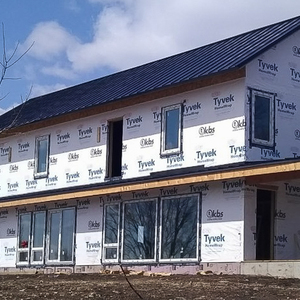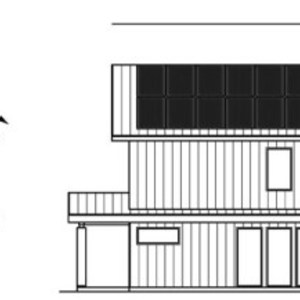
Editor’s Note: This is the first in a series of posts describing the construction of a net-zero energy house in Rochester, Minnesota, by Tracee Vetting Wolf, Matt Vetting, and their son Max. The family returned to the Midwest from New York and in December 2016 found a 27-acre parcel of rural land where they could build their new home. You can find their complete blog here. This post was written by Tracee.
Matt and I met training for Grandma’s Marathon, an annual event in Duluth, Minnesota. He was getting his Ph.D. in biochemistry as a protein chrystallographer and I was getting my master’s in architecture. We got to know each other over long runs and we learned that we paced each other very well.
But we never talked about energy efficiency until after we’d married. We were living in New York, and paying $4,000–$5,000 a year for oil to heat our drafty 1923 Sears home. Even then, the conversation wasn’t one of overall indignation about the state of the planet, climate change, or anything like that. The conversation was more about how fixed systems like oil production limit and dictate our personal choices.
We talked about how trapped we were by the oil market, knowing that its pricing was determined not only by supply and demand, but also by the politics of countries that struggle to get along, and by greed for money.
We lived in the Hudson Valley of New York for 16 years. Toward the end of that time, both of our professional careers were rocked by a volatile market. I was laid off at IBM and a year later, the grant that supported Matt’s research at Albert Einstein College of Medicine was terminated. We wanted a lifestyle that didn’t require us both to work in order to pay a mortgage. We were concerned about the risks we had stepped into by participating in the ethos of chasing upward mobility. Was this really our American Dream?
Finding beauty in Passive House design
As a trained architect, the lessons I learned about Passive House design principles always represented a certain kind of beauty to me — a beauty in how to live life if you were keen enough to leverage the resources around you. Passive House design principles were, in a way, representative of how to make choices that were sustainable, beautiful, comfortable, modern, free, sensitive, and responsible. This felt like a way to create our own American Dream that was based on a definition of abundance and prosperity not entirely focused on money.
So basically, I guess you could say that an energy efficient home was our idea of what an authentic American Dream looked like.
Building an energy efficient home was also a tractable way in which we could practice non-standard consumer choices to see if it could be done, and pave the way for others to make the same choices. We believe that as consumers, we need to make choices outside of those presented to us from within the fixed systems we live in. If we continue to play the money game in its current form, we continue to feed the environmental and political issues connected with global warming.
Most people believe that building codes provide the necessary scaffolding for building well, when in fact they represent a threshold below which you would be breaking the law. In short, you can do a whole lot better than code. And you would experience personal benefits for doing it. But you have to ask for it.
Thinking outside a closed system
It’s not easy to ask for things that are not part of the current repertoire. You need to find building professionals who are already beginning to practice new methods, or are willing to try. Not everyone is willing; there is resistance to doing something new or different. We certainly ran into that with our build, particularly with our HVAC choices.
So how do you convince people to do something different? Research and science doesn’t always have the evidence needed to substantiate new choices, but the lack of research isn’t proof that the choice is invalid; it only means that the research hasn’t been done yet. We relied on case studies, which helped us understand the impact of other people’s building choices and gave us confidence to insist on trying something that a particular building professional hasn’t done yet themselves. We want our house to be a case study for other people wanting to make different choices.
Together, we can create an authentic American Dream by making different choices within our fixed systems (which could also be applied to healthcare, the food industry and public education). How we choose to live our lives, spend our money (or not spend our money), and the values we strive to uphold can impact fixed systems to operate toward more authentic outcomes and the good of the planet. That’s why we built an energy efficient home.
Weekly Newsletter
Get building science and energy efficiency advice, plus special offers, in your inbox.















4 Comments
Hopefully someday the focus can shift from the increasingly nonsensical energy efficiency to LEI (low environmental impact). Or just call it "green building" :-).
“[Deleted]”
Since you've invoked the American Dream, upward mobility, careers, and cost of living, it would be very interesting to detail your shifts in income and living expenses and careers throughout this blog, as well as outlining the design of your house! With numbers and details!
Are you working remotely? Retired? Changed careers? Have you found architecture and protein crystallography work in your new rural community?
I'm not trying to be confrontational--I'm genuinely curious! As someone with an architecture career who has many romantic (and likely unrealistic) ideas about living in a more rural place, I'm curious about how your finances work for this lifestyle shift.
>Since you've invoked the American Dream, upward mobility, careers, and cost of living,
Noticed that too. A bit of Back to the Land there :)
Brendan,
FIRE is one way (Financial Independence and Retiring Early). The concepts and methods aren't Rocket Science but are challenging,
You asked for #s but I think the bigger challenges are personal and cultural. First I'll share some personal things that you rightly suspect will help out but I'm not convinced it's required.
I do work remote. My better half does not. We moved where he could find work. So remote isn't necessarily easier. If you have 0 debt, pay living expenses (oh and taxes), and up for subsistence living, there is a lot that can be done. That gets back to the personal and cultural issues.
In the US, the dominant culture doesn't make alternative approaches easy (aren't you supposed to build this huge, 3000 sq ft PASSIVE house with a Jumbo Loan that goes over budge and drains your savings? and drive a brand new Tesla every 3 years, etc.). Swimming upstream, aka. counter-culture, is no walk in the park. Personally, I shut down social media a few years ago, which makes me (more) immune to Keeping Up With The Jones. Again, that is a $0 change so I think you're focusing on the wrong thing.
I'll give you some examples that we've used in getting to a similar goal as the OP (so Net Zero home) that can help financially:
1. sweat equity / DIY skills - labor is the most expensive component of anything in the US, so avoiding hiring someone saves tons of $. Don't know how to install insulation? I go checkout tons of builder books from the local library and watch Joe Lstiburek's presentations online.
2. bartering - avoids fiat $ altogether. My friend introduced me to this: think of things you do well and that friends/neighbors do well, then do the swap.
3. 2nd hand - sounds easy but can disrupt the "instant gratification" culture we live in. 2nd hand delays projects b/c it's no longer a simple "Amazon Prime" push button process. This affects a lot of purchase decisions: transportation (used car, used bike, etc.), cookware, tools, etc. Another personal challenge with not buying new: Are you handy fixing, restoring / maintaining thing? There is no warranty to fall back on.
4. garden to table - food/grocery is about 1/4 of a household's budget, so if grow your food, and cook that food, then you _could_ save. Are you setup to do both? I like growing food. Thankfully my better half likes cooking :)
5. hand tools/methods over machine tools - this has carbon footprint and financial impact. Clothes line vs clothes dryer, hand wash vs dishwasher, stack affect cooling the home instead of A/C, etc. Avoid buying fuel for for machine hogs, etc. All of this sounds so easy, and cost $0! But doing things by hand?? I get stares from using our reel mower and scythe, plus it takes waaaayyyy more time than anyone plans to accomplish the same thing that a machine can do in the blink of an eye. There's even a Honey I Shrunk The Kids remote controlled machine mower now?! "Look at all the time I could save!" Yes, and all the money you'll spend on that slippery slope ...
And the most controversal for GBA: ...
... retrofit used, DON'T build new! - housing is 1/3 to 1/2 of a household budget! That should say where to focus if $ is on your mind. Avoid Jumbo loans, 2nd mortgages, "rationalizing" your way into 100 year payback calculations, etc.
Another counter-culture thought: will slashing your "Starbucks budget" or housing budget get you to your goals?
Hint #1: Dominant, popular budget "counselors" say Starbucks is the problem.
Answer: #1 I brew coffee at home but know that a trip to Starbucks isn't going to blow up my long term plans.
Answer #2: A huge variable rate mortgage that sinks me into negative equity = Huge problems.
We've been down both build & retrofit paths. Building our new Net Zero home was in the 2nd bid stage when we pulled out. We told our architect & GM that building wasn't meeting our financial goals even after the payback calculations. It was a tough decision to make. There was some cash burned by the effort (the design, the siting work, permits, etc.) but major, unexpected debt was avoided. And our build did get at other goals, like "green" materials -- our architect ordered site recycling, 2nd hand materials where available, FSC certified wood sourcing, avoided petrochemical (where possible), etc. -- but financially we couldn't justify getting _back_ into debt after freeing ourselves of so much indebtness over the years.
TL;DR: Back to Basics is a personal and cultural change. Financial methods, like FIRE, can help but getting _out_ of debt is the biggest factor IMO b/c it directly affects your original ask: income requirements.
I'm just as curious to hear what others, like the Wolf-Vetting family, have done.
P.S. Because you are an architect, I would ask the following;
1. Is sustainable both "green" and financial?
2. What are the financially sustainable challenges for architecture?
3. What about sustainable housing and the architecture community? Not HUD "affordable housing" but genuine multi-/single-family sustainability.
4. Is the Tiny House "movement" a reaction to McMansions? Are either good?
5. Why are "green" homes (almost entirely) custom designed?
6. How can design of Net Zero / LEED / PASSIVE -- especially Passive -- single family homes be built sustainably? Hint: the small home "penalty" that Passive Haus has, why not change this?
7. Is custom design & track housing still necessary for the architecture industry to sustain itself? i.e. the exreme from the mega-expensive PASSIVE home that's custom built to the Baby Boomer houses of 50's & 60's to the McMansions of 90's and 2000's, the homes are built en masse w/out care for energy ... can't there be something between these extremes? how can highly energy efficient homes be built with financially sustainable goals?
Log in or create an account to post a comment.
Sign up Log in